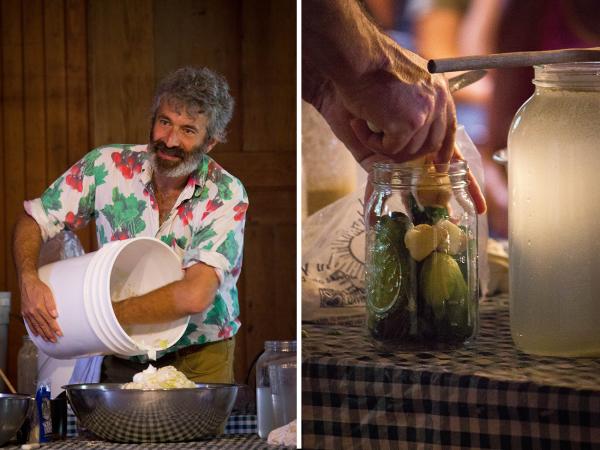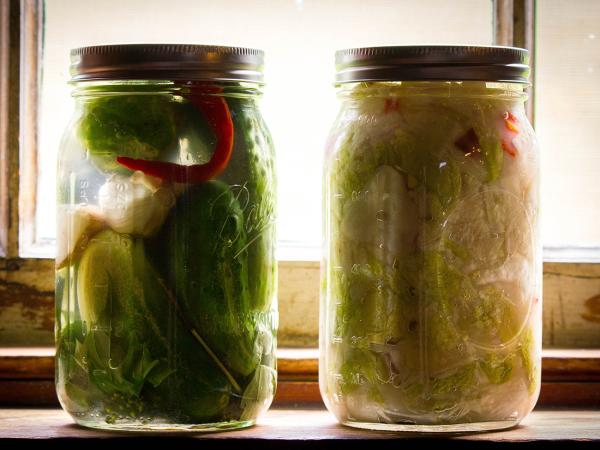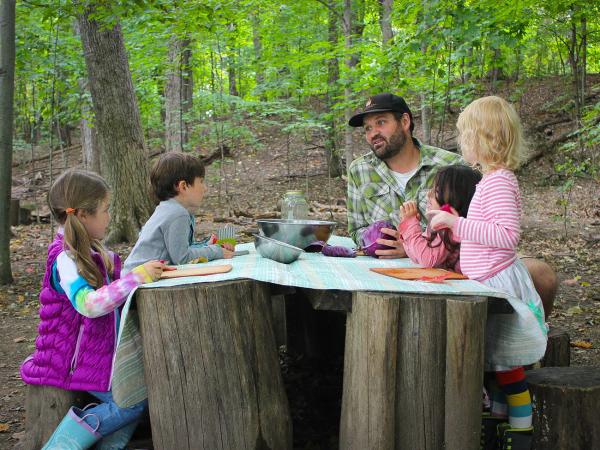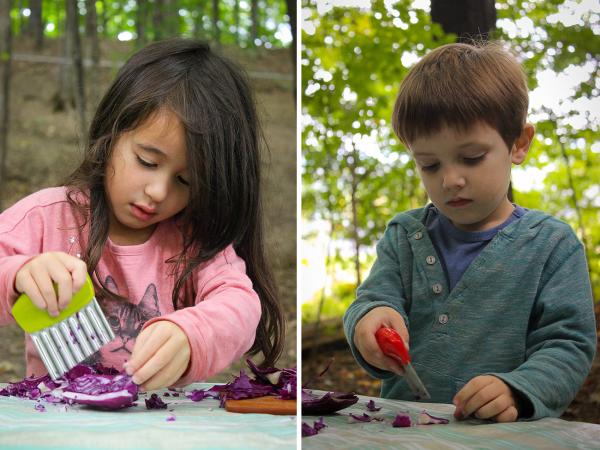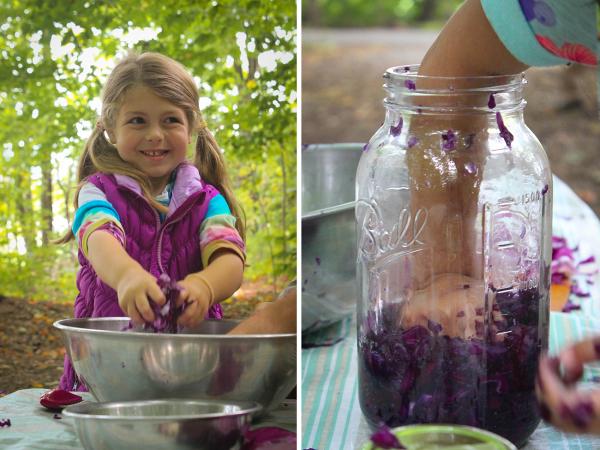We Are the Starter Cultures of Social Change
“The food that’s available through our system of mass production and mass distribution is nutritionally diminished, the methods that are used in food mass production are environmentally destructive, the divorce of food production from our local communities is economically devastating, and for all of these reasons people are becoming more interested in food. They’re reading the labels, wanting to know how the food is produced, wanting to meet local farmers, and be part of the local economy. And once you start asking questions like this about your food, you realize fermentation is part of the answer.”
— Sandor Katz, author and food activist
As part of a nation-wide tour of his newest book, Wild Fermentation, Sandor Katz led a summer workshop at the Farm about all things fermentation. Sandor is hailed as a thought leader in the importance of making and eating foods that are fermented, a process he defines as “the transformative action of naturally present microorganisms on our food.” By creating an environment where a community of naturally occurring, beneficial, and safe bacteria can break down foods, we’re able to have products that keep longer in our pantries and refrigerators, eat foods that have been physically broken down such that nutrients are more accessible, and replenish important gut bacterial communities that we haven’t nourished the same way our ancestors did since the advent and proliferation of antibiotics and antibacterial products. Researchers are just beginning to explore the links between beneficial bacteria and our physical and mental health. But even beyond the potential health benefits of fermented foods, the work of taking an abundance of fresh produce — be it wheat, dairy, vegetables, or fruit — and extending its shelf life is a way to strengthen our connection to the food we eat and deepen our understanding of where it comes from.
To put things in perspective, Sandor interestingly noted, “Fermentation is way older than the written word.” Hunters and gatherers transitioned to partially agricultural communities as farming techniques were developed. With a surplus of produce, a means of keeping crops over winter was necessary for the first time. This was the point in history when intentional fermenting most likely began. But, as Sandor reminds us, “Preservation isn’t the only reason we practice fermentation, but it is an important one.” The funky flavors and potential nutritional benefits of fermented foods and beverages are now reviving the fermentation tradition in a time where convenience is often king.
The flavors created from the bubbling transformation by fermentation are compelling, complex, funky, and a little on the edgier side. Since our brains are hardwired to adore and seek out all things sweet, the tastes of fermented foods sometimes take more effort to learn to love. The flavors “are sort of like stinky cheeses,” Sandor mused. “When you have a group of friends over and pull out a Camembert, inevitably someone walks in and says ‘Who died in here?!’ They would never dream of putting something that smelled like that into their mouths!” Luckily, a little repeated exposure can win over most skeptics. And, if you’re a fermentation advocate, you can always suggest the unwilling give up chocolate, coffee, breads, cheese, pickles, yogurt, beer, and wine — just a fraction of the fermented foods that comprise our regular diet. “The biggest thing I like to do with people who tell me they’d never eat fermented food,” Sandor advised, “is to help them recognize that they are eating and drinking the products of fermentation every day. It’s getting them to recognize that all fermented foods are not the same and… to seek out those products that aren’t cooked after they have been fermented. It’s those products that are rich in bacteria that will help us to restore and diversify our gut bacteria.”
The phrase “gut bacteria” isn’t exactly a conversation-starter — but it could be. “Our bodies have more bacterial cells than human cells,” Sandor explains, “and are important to our functionality and well-being. Bacteria-rich foods (fermented foods and beverages, especially those that aren’t cooked) are probiotic and replenish our gut bacteria.” And that could mean more than a happy digestive system. “Researchers are beginning to find that many physical and mental health issues have some sort of link with our gut bacteria. I don’t think we’ve gotten quite as far as recognizing what the mechanism is… but what we’re learning is that gut bacteria has implications for all of these systems of our bodies.” Furthermore, bacteria start working their nutritional magic right when fermentation begins: they break down food to make its inherent minerals and nutrients more immediately available to our bodies. Additionally, fermentation can break down toxins (including cyanide, found naturally in cassava) and create unique nutrients that are by-products of the process.
And fermentation is safe. A common misconception is that the process can easily go awry and the products will make us ill; however, the USDA has not found a single reported case of illness due to fermented foods ever.
Sandor closed his workshop that summer day with this thought: “We are the starter cultures of social change.” Just as a small, saved amount of one fermented food can be used to create a whole new batch — like sourdough breads, for instance — one small group of people can share their knowledge and grow an idea. This is essentially what our work is all about at Shelburne Farms: we introduce kids to experiences and ideas on the Farm that build bonds between them and the environment. They can take this connection with the natural and agricultural worlds wherever they go to build a personal ethic that serves both people and the planet.
But there’s a more tangible relationship between Sandor Katz and our work, too. At Shelburne Farms, we expose kids to hands-on, place-based experiences to explore where our food comes from and how it’s made. And, as kids become more familiar with the origins of their food and try new tastes, they’re more likely to carry an open mindset and good habits into adulthood. So, we brought Sandor’s lessons of getting involved with your food into our own outdoor classroom, and made sauerkraut with our preschool campers — the Adventures group!
“Watching Sandor make sourdough and sauerkraut during our summer workshop reminded me of working with groups of children in a mud kitchen, at a sensory table, or making dough for bread” Jed Norris, Early Childhood Program Coordinator, remembers. “[Having kids] touch and work directly with food is important to me as an educator; I place a high value on food as a part of the culture of a classroom.”
So one early autumn camp day, Jed and his fellow educators set up a wooden table in the forest, just beyond the Farm Barn, with cutting boards, large bowls, jars, salt, and kid-safe wavy choppers. The Adventurers gathered, chopped up fresh purple cabbage into tiny bites, spread salt all over the pieces, and worked their hands into the mixture to release the water from the leaves (and stain a few hands magenta in the process). Little fingers stuffed a Mason jar full of the sauerkraut-to-be, and a few weeks later, it was time to taste test. “With a few bites down some were not prepared to say they liked the sauerkraut,” Jed reported, “but one girl loved it and had multiple helpings! At the very least, they were engaged in the process of making a dish through the work of their own hands. A win in my book.”
You can read more about Sandor’s work with fermentation in the second editing of his first book, Wild Fermentation, published by Chelsea Green. For more outdoor and food related activities for preschoolers, check out Cultivating Joy and Wonder, available for purchase and free download.

